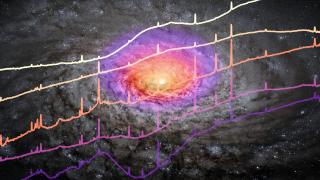Bibcode
Göttgens, Fabian; Weilbacher, Peter M.; Roth, Martin M.; Dreizler, Stefan; Giesers, Benjamin; Husser, Tim-Oliver; Kamann, Sebastian; Brinchmann, Jarle; Kollatschny, Wolfram; Monreal-Ibero, Ana; Schmidt, Kasper B.; Wendt, Martin; Wisotzki, Lutz; Bacon, Roland
Referencia bibliográfica
Astronomy and Astrophysics, Volume 626, id.A69, 6 pp.
Fecha de publicación:
6
2019
Revista
Número de citas
17
Número de citas referidas
17
Descripción
A nova is a cataclysmic event on the surface of a white dwarf in a
binary system that increases the overall brightness by several orders of
magnitude. Although binary systems with a white dwarf are expected to be
overabundant in globular clusters compared with in the Galaxy, only two
novae from Galactic globular clusters have been observed. We present the
discovery of an emission nebula in the Galactic globular cluster M 22
(NGC 6656) in observations made with the integral-field spectrograph
MUSE. We extracted the spectrum of the nebula and used the radial
velocity determined from the emission lines to confirm that the nebula
is part of NGC 6656. Emission-line ratios were used to determine the
electron temperature and density. It is estimated to have a mass of 1-17
× 10-5M⊙. This mass and the
emission-line ratios indicate that the nebula is a nova remnant. Its
position coincides with the reported location of a "guest star", an
ancient Chinese term for transients, observed in May 48 BCE. With this
discovery, this nova may be one of the oldest confirmed extra-solar
events recorded in human history.
Datacubes are also available at the CDS via anonymous ftp to http://cdsarc.u-strasbg.fr
(ftp://130.79.128.5) or via http://cdsarc.u-strasbg.fr/viz-bin/qcat?J/A+A/626/A69
Proyectos relacionados

Actividad Nuclear en Galaxias: una Perspectiva 3D del Núcleo y su Entorno
Nuestro proyecto puede dividirse en dos líneas principales de investigación. En primer lugar, el estudio de los vientos producidos por cuásares luminosos oscurecidos y del impacto que estos tienen en sus galaxias anfitrionas (retroalimentación del AGN). Para ello hemos obtenido observaciones en el óptico e infrarrojo cercano con el Gran Telescopio
Cristina
Ramos Almeida